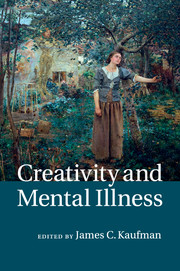Book contents
- Frontmatter
- Dedication
- Contents
- List of figures
- List of tables
- List of contributors
- Preface
- Acknowledgments
- Part I Creativity and mental illness: the state of the field
- Part II Cognitive and neuroscientific perspectives on creativity and mental illness
- 5 Neurocognitive mechanisms underlying creative thinking: indications from studies of mental illness
- 6 The evolutionary genetics of the creativity–psychosis connection
- 7 Non-linearity in creativity and mental illness: the mixed blessings of chaos, catastrophe, and noise in brain and behavior
- 8 Artists’ vulnerability to psychopathology: an integrative cognitive perspective
- Part III Creativity and the spectrum of mental illness
- Part IV Creativity and mental illness: possible commonalities
- Part V Creativity and mental health
- Part VI Creativity and mental illness: what now?
- Index
- References
6 - The evolutionary genetics of the creativity–psychosis connection
from Part II - Cognitive and neuroscientific perspectives on creativity and mental illness
Published online by Cambridge University Press: 05 August 2014
- Frontmatter
- Dedication
- Contents
- List of figures
- List of tables
- List of contributors
- Preface
- Acknowledgments
- Part I Creativity and mental illness: the state of the field
- Part II Cognitive and neuroscientific perspectives on creativity and mental illness
- 5 Neurocognitive mechanisms underlying creative thinking: indications from studies of mental illness
- 6 The evolutionary genetics of the creativity–psychosis connection
- 7 Non-linearity in creativity and mental illness: the mixed blessings of chaos, catastrophe, and noise in brain and behavior
- 8 Artists’ vulnerability to psychopathology: an integrative cognitive perspective
- Part III Creativity and the spectrum of mental illness
- Part IV Creativity and mental illness: possible commonalities
- Part V Creativity and mental health
- Part VI Creativity and mental illness: what now?
- Index
- References
Summary
Why is it that all those who have become eminent in philosophy or politics or poetry or the arts are clearly melancholics?
– AristotleNothing in biology makes sense except in the light of evolution.
– Dobzhansky (1973)Introduction
Schizophrenia, a debilitating mental illness affecting roughly 1 percent of the population worldwide, is widely accepted as being highly genetically influenced (Cardno et al., 1999; Gershon et al., 1988; Kendler and Diehl, 1993). Schizophrenia is often marked by distortions of reality, disorganized thought, emotional blunting, and/or social isolation that may interfere with optimal functioning (Cornblatt et al., 2012). Schizophrenia may be associated with creativity, although research findings are mixed (e.g., Andreasen, 2011; Kyaga et al., 2013). Evidence also points to adverse effects on fertility and reproductive success among (particularly) males with schizophrenia (Svensson et al., 2007), in part accounted for by marital status (McCabe et al., 2009), suggesting potential biological and social influences. Collectively, this raises an intriguing potential evolutionary puzzle: How does schizophrenia persist in the population at a stable prevalence rate too high to be explained by simple random mutation? (Doi et al., 2009; see also Del Giudice et al., 2010). Among various hypotheses, including in the context of the emerging field of evolutionary epidemiology, schizophrenia may represent “one extreme of a sexually selected fitness factor” (Shaner et al., 2004).
- Type
- Chapter
- Information
- Creativity and Mental Illness , pp. 102 - 132Publisher: Cambridge University PressPrint publication year: 2014
References
- 3
- Cited by



